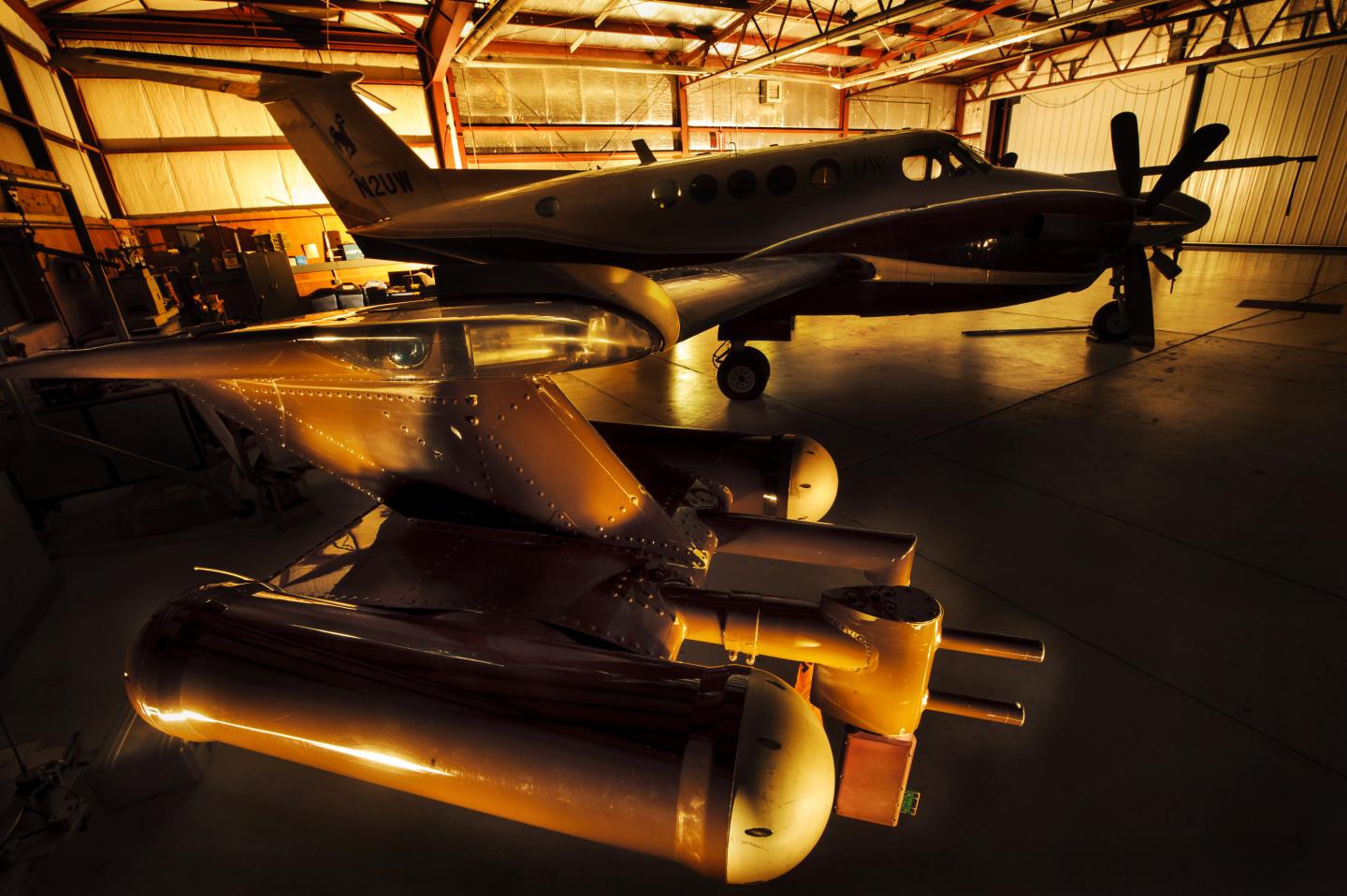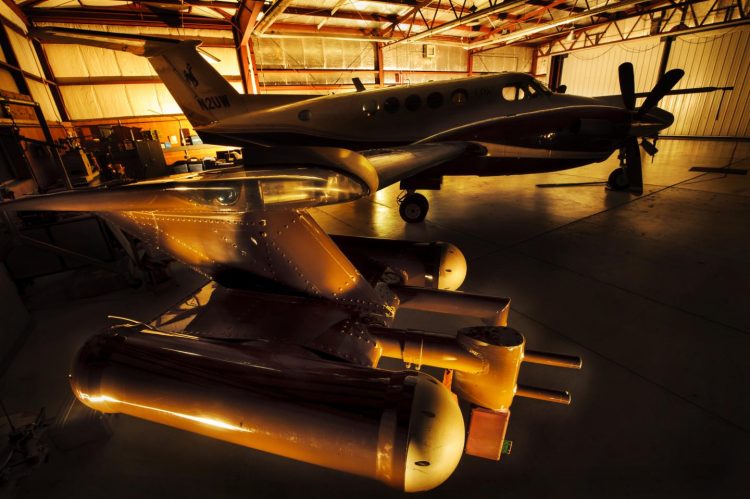
Credit: University of Wyoming
The University of Wyoming received a $15.8 million National Science Foundation (NSF) grant that will provide weather instrumentation and other equipment for a new King Air research aircraft the university plans to purchase.
The grant was announced today (Sept. 17) for UW, which is the only academic institution in the United States that provides a research aircraft facility to the atmospheric science community.
“The grant is for modifying and certifying the aircraft that UW is about to purchase, and also to develop new instrumentation for use on this aircraft, primarily for atmospheric remote sensing,” says Bart Geerts, chair and professor in UW’s Department of Atmospheric Science.
Last week, the UW Board of Trustees voted to approach the State Loan and Investment Board to acquire a loan for up to $4.7 million for the purchase of the aircraft. The current King Air twin-engine turboprop is 42 years old and is life-limited.
“As part of our NSF MSRI (Mid-Scale Research Infrastructure) proposal, the university made a commitment to purchase a new research aircraft, and that is expected to happen in the next few months,” says Geerts, who is principal investigator for the grant project. “The loan for this purchase will be serviced through the indirect cost generated by King Air-related grants.”
The NSF grant award totals $15,810,587 over five years for UW for support of the project, “The Next-Generation Wyoming King Air Atmospheric Research Aircraft.” This grant is based on a proposal submitted earlier this year by Geerts; and co-principal investigators Jeff French and Dana Caulton, UW assistant professors of atmospheric science; Shane Murphy, a UW associate professor of atmospheric science; and Zhien Wang, a professor of atmospheric and oceanic sciences at the University of Colorado, in response to the NSF MSRI grant solicitation. This was a competitive solicitation for up to $20 million across all STEM disciplines.
“This grant is essential to the strategic vision of the Department of Atmospheric Science to build the next generation UW King Air research aircraft, with an array of state-of-the-art remote sensors,” Geerts says. “This facility will be a resource for the department’s faculty and students, the UW community and for the state of Wyoming for decades to come, in ‘hot’ research areas such as air quality, fugitive emissions, wildfires, severe storms, winter weather and water availability.”
The Department of Atmospheric Science has been operating its current King Air atmospheric research aircraft since 1977, when it was purchased for $1 million. Over the ensuing years, additional millions have been awarded by NSF and other federal agencies for instrumentation and airframe modification, such as for radar and LIDAR.
Since 1988, the King Air has been part of the NSF Lower Atmosphere Observing Facilities (LAOF) Program, which provides base funding to UW to deploy the aircraft and its instruments in support of NSF-funded research. Under the cooperative agreement, the NSF provides over $2 million in base funding annually to UW. The funding helps pay for the staff of 16 individuals, including engineers, technicians, two mechanics and three pilots to maintain and fly the aircraft. In exchange, UW provides the plane and instrumentation to NSF-funded investigators as “a national facility.”
“The new instruments supported with the NSF grant will enable capabilities that are not currently available on any of the aircraft in the LAOF fleet,” Geerts explains. “Specifically, this grant will convert a relatively new, slightly larger King Air aircraft, to be owned by UW, into an atmospheric research platform more capable than the current aircraft; equip it with instruments that allow new research perspectives; and bring these new capabilities to a technical readiness level and a data accessibility level where they can be requested and used by the NSF-funded community.”
The new instruments will enhance the King Air’s already strong tropospheric profiling capabilities. In particular, this includes clear-air measurements of humidity, temperature, aerosol and 3D winds (Raman LIDAR and Doppler LIDAR), a project led by Wang; and improved measurements of cloud and precipitation properties (dual-frequency mm-wave radar system), a project led by Samuel Haimov, a UW senior research scientist in atmospheric science.
“These remote sensors, deployed in synergy, together with a series of atmospheric chemistry probes (a project led by Caulton), will make the new King Air a supreme yet cost-effective airborne lab,” Geerts says.
Finally, Matt Burkhart, another UW senior research scientist in atmospheric science, will lead the development of an advanced air-to-ground communication technology system, allowing scientists and students an immersive and highly informed flight experience from the ground, thus enabling remote flight decisions.
“The King Air will serve as an ideal platform for the Department of Atmospheric Science to grow its competitive research portfolio and to train the next generation of observational atmospheric scientists,” Geerts says.
Research Capabilities
The current aircraft’s remote-sensing capabilities include the radar and LIDAR. LIDAR, an acronym for light detection and ranging, is an optic remote sensing technology that can detect and measure cloud droplets in the atmosphere. Water droplets and ice crystals are detected by multiple beams of the radar and can be used to produce dual-Doppler wind analyses. Both the radar and LIDAR can provide vertical “curtain” views of cloud structure.
For an NSF video of LAOF program activities that include the King Air, go to http://content.
Typical missions, which can fly up to an altitude of 28,000 feet, include studies of boundary layer structure, air-sea interactions, cloud and aerosol physics, troposphere profiling and atmospheric chemistry.
About 50 percent of the research conducted with King Air is related to cloud physics. Another 30 percent focuses on aerosols and air quality, French says. The remaining 20 percent of the aircraft’s research hours are spent on the exchange of energy between the surface of the Earth and its lower atmosphere.
For a number of years, Geerts has used the King Air for a cloud-seeding or weather modification study administered by the Wyoming Water Development Office. Cloud seeding focuses on a process in which silver iodide is released into the clouds through generators strategically placed upwind of mountain ranges. The silver iodide facilitates ice crystal formation. Due to water shortages and droughts in some states and in countries around the world, cloud seeding is seen as a potential way to increase water supplies for communities and for irrigation of crops.
In 2015, Geerts received a $1.15 million NSF grant and used the King Air to study how thunderstorms form at night over the southern Great Plains.
In December 2013 and January 2014, Geerts was one of the lead investigators in the Ontario Lake-Effect Systems (OWLeS) project. The study was conducted to better understand why so much lake-effect snow falls on the shores of Lake Ontario in northern New York state each winter.
During the past few years, researchers elsewhere have used King Air for projects in Antigua, Dominica, England and Finland.
###
For a rundown of UW King Air research deployments since 2004, go to http://flights.
Media Contact
Bart Geerts
[email protected]
Original Source
http://www.





